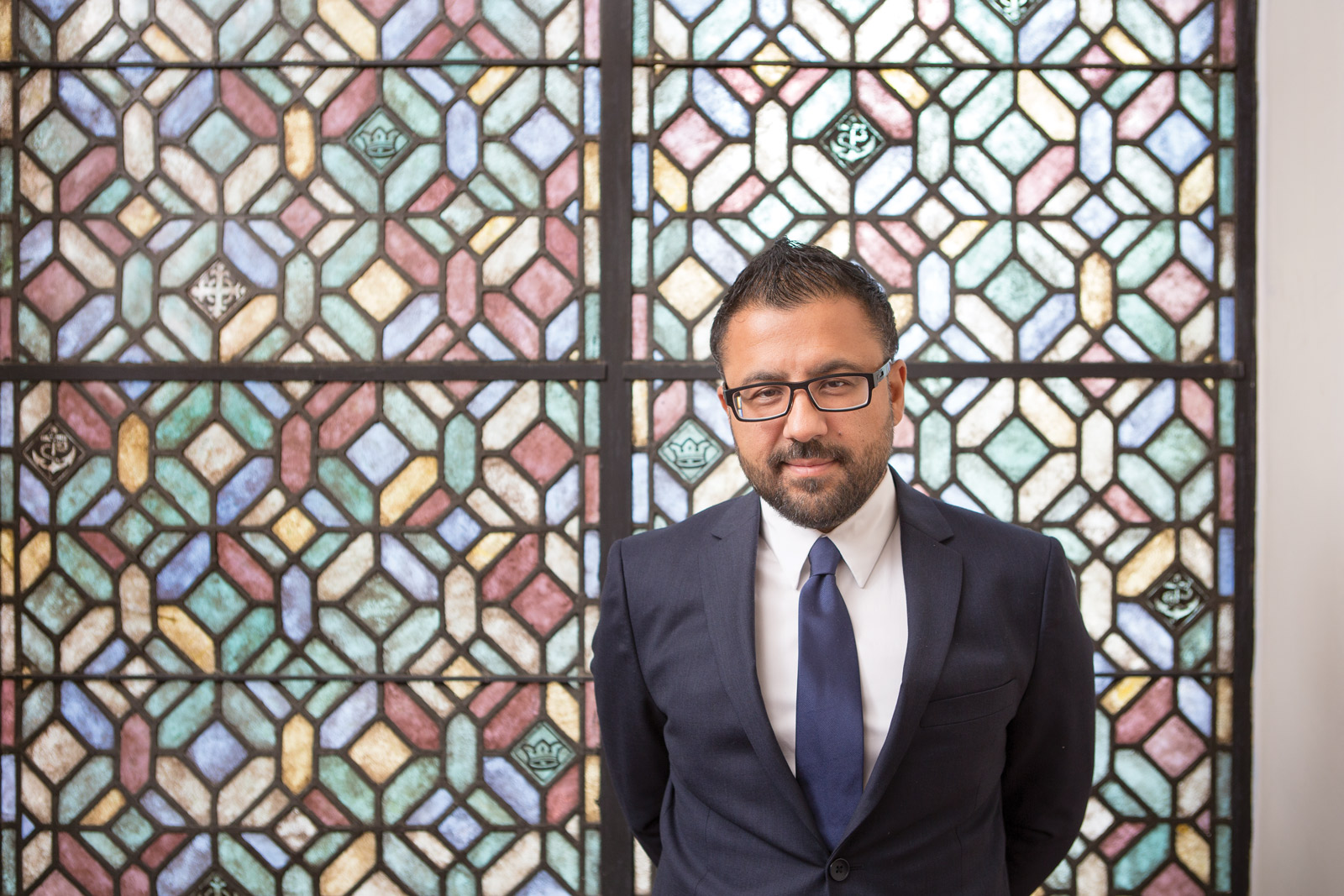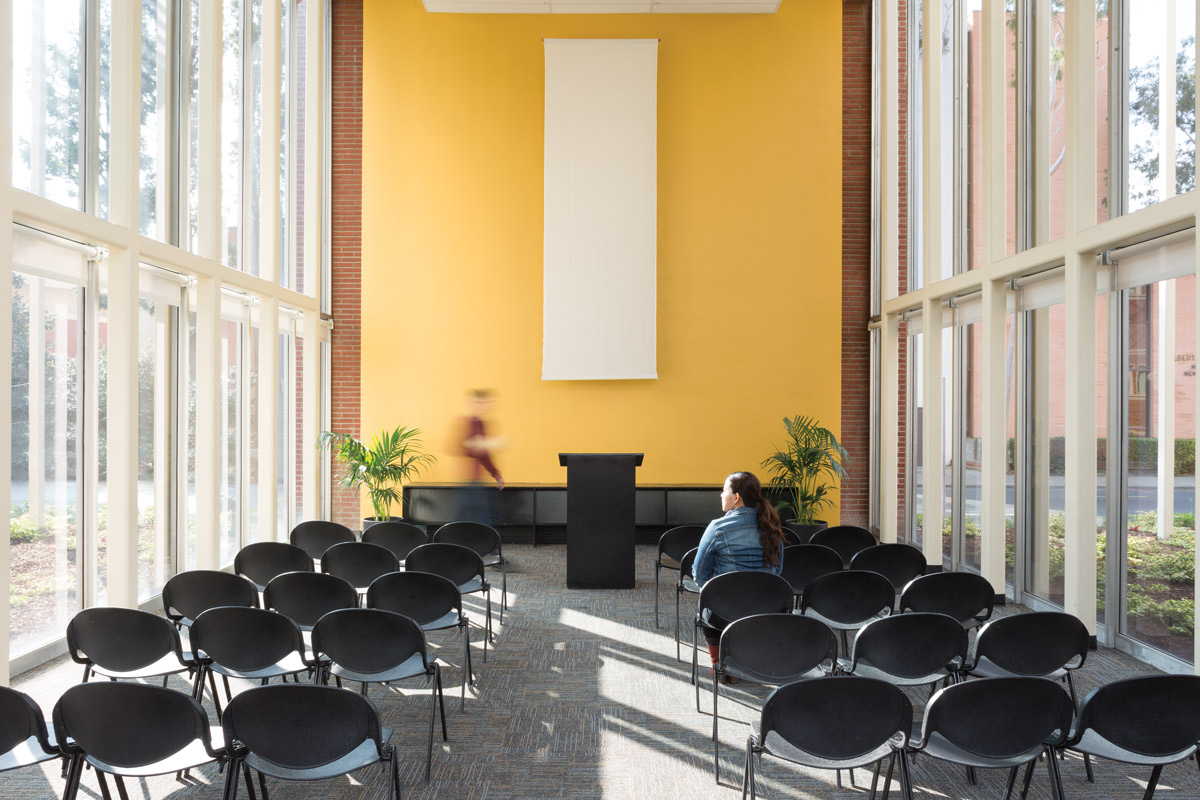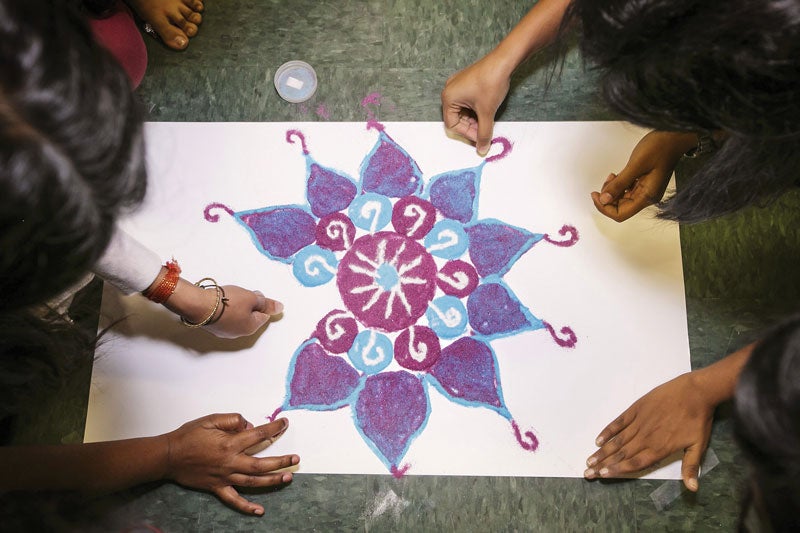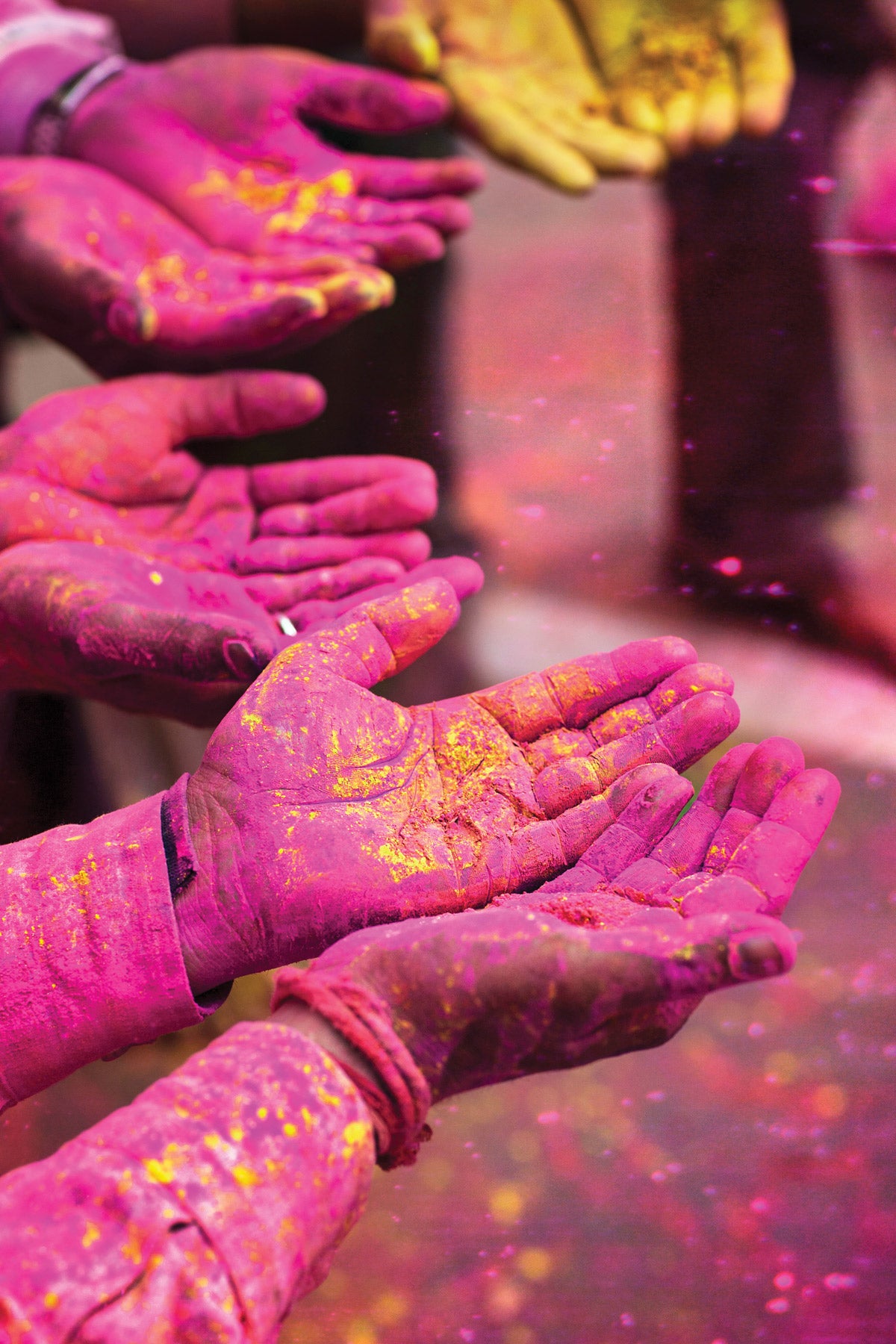Spirituality and Secularism Get Along at an Interfaith USC
USC’s Office of Religious Life encourages Trojans to explore spirituality — and find a deeper faith by doing so.
One by one, men and women enter the glass-walled room at USC’s University Religious Center on the north side of the University Park Campus. Each grabs a sandwich and finds a seat at tables pieced together into a large U.
The white-noise chatter of colleagues catching up permeates the air, but this gathering serves a purpose beyond academic small talk. Those in attendance serve a higher power—or powers, more accurately. Varun Soni, USC’s dean of religious life, calls the meeting to order.
Recent Diwali festivities honoring the Hindu tradition were a success, Soni tells the crowd. So was Homelessness Awareness Week, presented in part by USC’s Interfaith Council. Next up: a turban-tying meetup held by the USC Sikh Student Association, a performance by USC’s Saved By Grace gospel choir and a conversation with the authors of the book The Internet Is My Religion, presented by the USC Secular Student Fellowship.
Attendees scribble notes between bites of lunch. They’re a good percentage of USC’s 60-plus chaplains, who represent many of the 90-plus religious groups on campus—more chaplains and groups, it turns out, than at any other American university.
“We have religious groups representing every faith tradition, including many denominational perspectives,” Soni says after the meeting. “So it’s not just that we have Christians, we have 40 different Christian groups, we have four different Hindu groups, we have five different Jewish groups.” That’s due in part to USC’s population: 42,000 students representing 140 countries and every U.S. state.

The campus’s location helps, too: Los Angeles is one of the most religiously diverse cities in the world. According to Soni, there are 70 houses of worship within a square mile of campus, and 12,000 in Southern California. He’s about to offer up another fact when a spirited conversation erupts in the hallway. “[They] must be talking football,” he says with a laugh. “That’s the real religion on campus.”
There are 70 houses of worship within a square mile of campus, and 12,000 in Southern California.
USC’s multifaceted relationship with religion goes back to its beginnings in 1880, when it was founded in affiliation with the Methodist Church by three men: a Protestant, an Irish Catholic and a rabbi. (No, they didn’t walk into a bar—they joined together to donate the land upon which USC was built.) USC became a completely secular school in 1957, but spirituality on campus has deepened. The Office of Religious Life was founded in 1996 “as a way of thinking about how the university can support religious and spiritual life, broadly conceived,” says Soni, who became the office’s dean in 2008.
Soni may have the personable temperament typical of a university chaplain, but he’s quite a departure from many of his counterparts in academia. His scarf—patterned with the Grateful Dead’s Steal Your Face logo—is the first hint. He’s the first Hindu to ever hold a position like this in the U.S., and for a long time, was the only non-Christian to have the job. (Dartmouth hired a rabbi for a similar position in 2016.) And though he’s a professor of religion who once studied at a Buddhist monastery, he’s not ordained in any tradition. He’s also a lawyer, former radio show host, television consultant and graphic novel producer.
But what differentiates Soni most is the way he runs the office. “You know, the secret is that really, I’m much more interested in what it means to be human than what it means to be divine,” he says. It’s one of the main reasons that during a time when more and more millennials are eschewing religion, USC’s Office of Religious Life is flourishing. (Story continues below.)
USC students douse each other with dry powder and colored water on McCarthy Quad to celebrate Holi, a Hindu festival that welcomes spring with bursts of color and fun. In the bottom photo by David Sprague, students celebrate the Hindu festival of Sankranti.
Reverend Jim Burklo, the office’s white-haired, impressively mustachioed associate dean, has the warmth you’d expect from a progressive Christian pastor. He echoes Soni’s sentiments: “The big change happening on our campus, and many other campuses, is we have more and more students who are not affiliated with any religion and are not even looking to be affiliated with a religion,” he says. According to the Pew Research Center, 25 percent of American college graduates do not associate with a faith label, the highest percentage in 40 years.
At USC, Soni estimates that 13,000 students, nearly a third of the school’s population, don’t identify with a formal religious tradition. “But they’re totally fascinated with spirituality, matters of the soul, values, all that,” Burklo says. “So we see ourselves more and more aimed at serving that growing population.”
25 percent of American college graduates do not associate with a faith label, the highest percentage in 40 years.
That’s why, at Soni’s monthly meetings, alongside the leaders of groups like the Association of Baha’i Students and the Christian Science Organization, you’ll find Bart Campolo, USC’s humanist chaplain. Though Campolo is part of a small but growing group of secular chaplains at American universities, he’s the first in the country to be formally brought into the fold of a school’s office of religious life. It’s not hard to imagine Campolo, a dynamic guy with an easy smile shored by deep dimples, in his former life as an Evangelical pastor. “About five or six years ago, I came to the place where I was still committed to social justice, loving relationships, community, all these good values, but lost my ability to believe in that central core narrative of God and Jesus,” Campolo says. “So I wandered around trying to figure out what you do if you’re a minister who doesn’t believe in God.”
For Campolo, the answer was secular humanism, and Harvard’s humanist chaplain suggested he get in touch with Soni, who invited him to come to USC. “Dean Soni told me, ‘There’s nobody nurturing our secular students’ spirituality in the way you’re talking about,’” Campolo says.
It’s just one of the ways students are being “met where they are.” In 2014 the Office of Religious Life launched the popular Mindful USC initiative, bringing secular-style meditation practices to campus. The office also supports groups and programming for a student body hungry for diversity: The Interfaith Council includes students of all faiths. They get together weekly for pizza and discourse, while organized “Souljourn” trips take students to different places of worship around Los Angeles.
Last semester the office helped promote “Race, Faith, and Violence,” a series of lectures with three scholars-in-residence: a Jew, a Muslim and a Christian. Students, Soni says, “are more and more interested in personal experience, service, interfaith engagement, and reflection and community. That’s why we want to build the office of tomorrow, not the office of yesterday, because we’ll be irrelevant if we don’t.”
Petra Reyes, a junior majoring in political science, is just the kind of student Soni is referring to. Reyes grew up in a Reform Jewish community in the Bay Area and wasn’t too concerned about how she would continue her religious observance once she was at school.
“You don’t realize how important spirituality and a religious community is until you’re separated from the one that you’re most familiar with,” Reyes says. “I had gone into USC thinking, OK, great, I’ll be able to find a Jewish community that I vibe with.” But her idea of what it means to be religious has shifted. “To me my spirituality is not davening and praying consistently. Most of my religion while in college has been through social activism and through organizations that put my Jewish values into action, whether it’s [addressing] the conflict in Israel and Palestine, or pushing propositions in California. I think the beauty of Judaism is that it’s what you make it.”
Re-examining one’s relationship to faith is a common challenge for incoming students. Junior Mary Cate Hickman, who was born and raised as a devout member of the Church of Jesus Christ of Latter-day Saints (LDS) in Tulsa, Oklahoma, wrestled with the internal struggle last year. “At church we call it the ‘trial of your faith,’” says the double major in film critical studies and religion. “Of course it’s easy to grow up in a family that’s Mormon and have the only religious input being what you already believe. I was going to Interfaith Council and I was in a religion class learning about the rise of the three great monotheistic religions of Islam, Judaism and Christianity.” It made her take a hard look at Mormonism and ask, “Do I actually believe this?”
“You have one of two options: You turn away from your faith and try to figure it out on your own, or you actually learn what the word faith means and you press forward,” says Hickman, who’s now president of the Interfaith Council and also active with USC’s LDS ward. “That’s what I did. I pressed forward. I continued to be challenged by my religion classes and Interfaith meetings, but I just had to work that much harder on my own faith to learn what was true for me.”
For sophomore Briana Trujillo, a journalism and international relations double major, it wasn’t a crisis that deepened her faith, but rather taking religious practice into her own hands after moving 3,000 miles from her Miami home. “My family is Catholic. It was always just a part of our life and our identity,” she says. She attended “Mass on the Grass” hosted by Our Savior Parish as a freshman (an event she also brought her Muslim now-boyfriend to) and has since become a regular at the USC Caruso Catholic Center. How has has her faith changed since coming to USC?
“I want to say that it’s stronger,” she says. “Because I’m on my own, I have to decide to go to mass. I have to decide to go to Bible study.”
I don’t like to limit myself to befriending only people of my faith tradition; I feel like that would be a strange life.
Noor Alwani
But Catholicism isn’t the only religious tradition Trujillo sought out as a new USC student. “I dipped into the front office of the URC and I was like, ‘Hi! I think religion is really beautiful, and I want a space to explore that,’” she says. It’s this ability to experience the inherent diversity of college that many religious students find so refreshing. “I grew up with a lot of my friends being Jewish because I was really involved in my community. It’s not because they were Jewish, it’s because they believed in the same things that I did. They cared about the world,” Reyes says. “The fun thing about college is that you can find people like that and they’re not specifically in your religious community.”
That’s something that also appeals to freshman Noor Alwani, a psychology major minoring in international relations who was raised Muslim in a D.C. suburb. “I don’t like to limit myself to befriending only people of my faith tradition; I feel like that would be a strange life,” she says with a laugh.
Alwani is on the executive board of USC’s Ansar Service Partnership, a community service organization based on Islamic values, and has also found comfort in the school’s interfaith community, which, she admits, presents its own challenges. “It’s harder because if you were to forget to pray for a day, you don’t have much of a support system to hold you accountable, especially as a college student living among non-Muslims. If I were to eat on a day I was supposed to be fasting, no one would know,” she says. “But I think it strengthens your personal connection with God.”
Fostering interfaith dialogue is clearly a crucial element of USC’s religious life, and, according to Soni, a powerful one. “I think the most important work we do is what very few people will actually see,” he says. “And that’s the interpersonal transformation that’s happening when students from different perspectives meet each other.” It may not be quantifiable, but it can certainly be seen.
“We did a vigil for our Muslim students,” Soni says, recounting the aftermath of the 2015 shooting of three Muslim students in Chapel Hill, North Carolina. “Bart [Campolo] was there, he offered a secular prayer, and our Evangelical pastors were there and they offered a Christian prayer, and a Sikh leader showed up and she offered a Sikh prayer. It’s not that we had a vigil and tried to make it interfaith-y. We had a vigil and when our community showed up they were representing different faiths and felt very comfortable mourning with our Muslim students. It wasn’t gimmicky, it was organic.”

Of course, there’s always more work to be done. Alwani mentions that she doesn’t wear a headscarf because it can make her feel unsafe, especially in the nation’s current political climate. But if there’s one place she does feel protected, it’s the University Religious Center, or URC. As Burklo says of the URC, “the joint jumps.”
On any given night, you might hear Evangelical Chinese students singing praise songs in Mandarin, Buddhists chanting the Lotus Sutra, the Bhakti Club playing Hindu devotional music or Muslims saying their daily prayers. “It’s like a symphony of world religions,” Burklo says. “It’s such a peaceful place,” Alwani adds, “where people value tolerance and they value freedom of expression. I wish that would translate to the rest of our … country, really.”
On a chilly night toward the end of the fall semester, a group of Interfaith Council students gathered in the URC’s courtyard around a barbecue, stoking a small fire in preparation for the twice yearly prayer-burning ceremony.
For the past few months, Burklo had been collecting the scrawled-upon pieces of paper in a prayer box at the non-denominational Little Chapel of Silence. That night, Hickman took the thick stack, and passed the prayers out—to a Catholic, a Baptist, several secular humanists, a Russian Orthodox, a progressive Christian and a Confucian, among others. The students took turns reading prayers before dropping them into the flames. Many were addressed to God, some to Allah, and one lighthearted prayer to “my dude.”
—They are prayers for healing, strength and peace. One student held up several prayers and asked if anyone could read Korean or Arabic.
No one gathered there could, but it didn’t matter.
The prayers were dropped on the fire with the same measure of reverence, the paper curling and burning, the smoke rising into the air.


